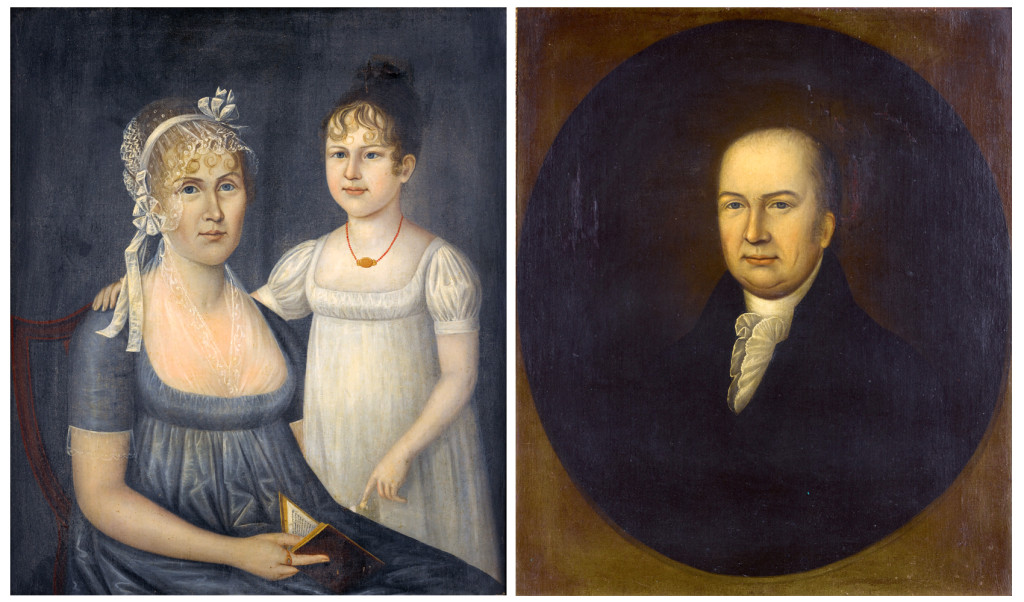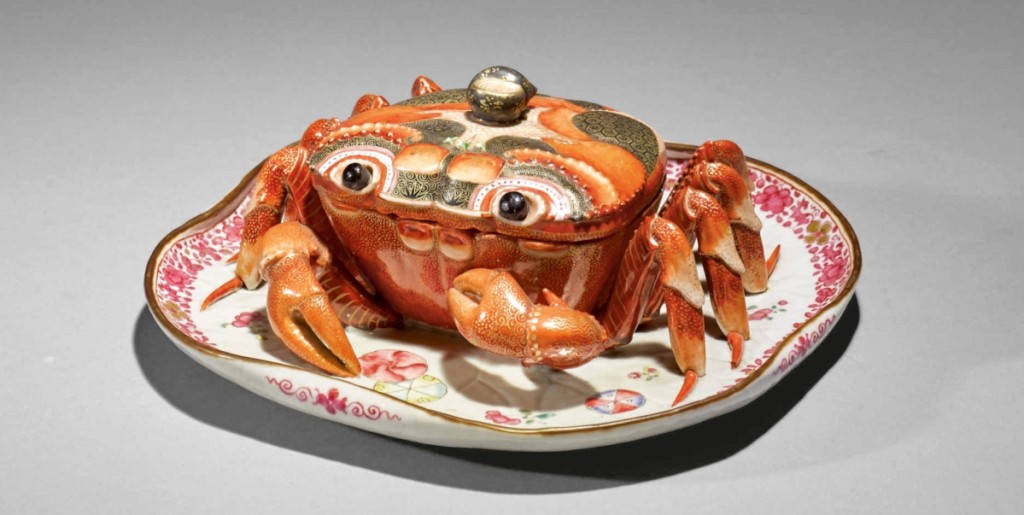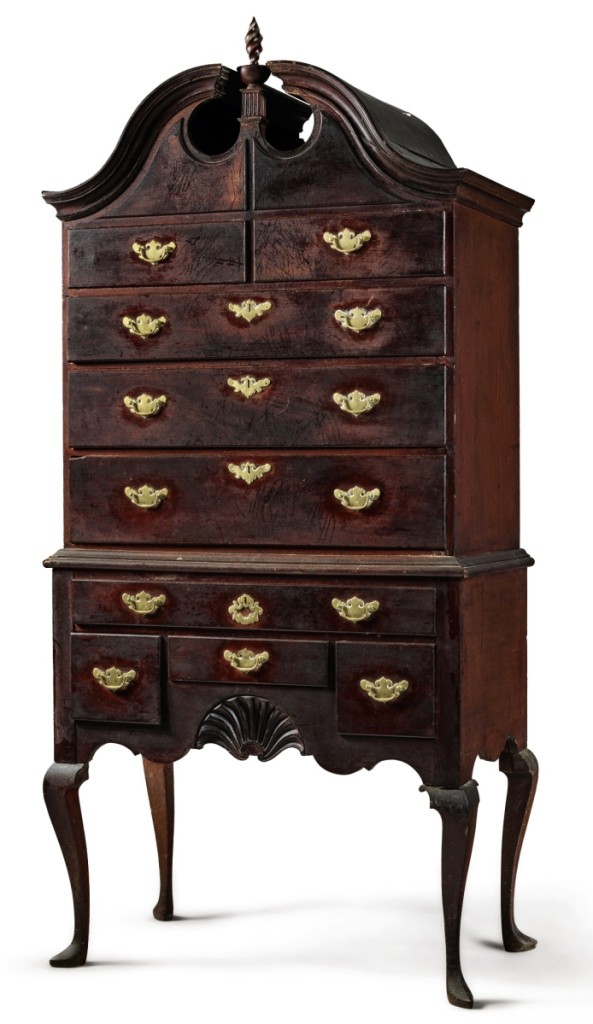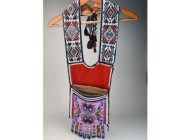
Joshua Johnson proved very popular this season, with this pair of family portraits of Dr and Mrs Andrew Aitkin and their daughter, Eliza, bringing the top price of any sale conducted at Sotheby’s during Americana Week. Consigned from a private Maryland collection, the family portraits sold for $675,000, more than ten times their low estimate ($60/80,000), and set a new record for the artist.
Review and Onsite Photos by Madelia Hickman Ring
NEW YORK CITY – Sotheby’s annual Americana Week featured sales of American furniture, folk art, silver, prints and Chinese export sections interspersed with three single-owner collections of folk art, decorative arts and furniture. Exhibitions for all of the sales were placed throughout Sotheby’s and the volume of offerings was significant. Over the span of four days of sales, January 17-20, more than 1,400 lots would cross the block, selling for a cumulative total of $16,818,817. Speaking after the sale, Sotheby’s head of American furniture, Erik Gronning, commented, “We are pleased with the results of our 2019 Americana Week thus far – our horses galloped, eagles soared, Shaker shook, ceramics shone and furniture shined through its original old surface. As the results show, both old and new clients responded very favorably to our continued curated presentation of Americana as exceptionally made and historically important works of art. It is with this enthusiasm that we look forward to [the January 24] dedicated offering of Fine Manuscript & Printed Americana, which will conclude our strong auction series this year.”
Silver
The silver section at Sotheby’s got off to a poor start, with only five of the first 20 lots finding buyers. By the time the nearly 100 lots of American silver had crossed the block, approximately 45 percent of the lots had sold. The top lot of the section was a mixed-metal pitcher by Tiffany & Co., that made $81,250 against an estimate of $40/60,000.
Prints
Buyers responded more favorably to the offerings of prints. Of the 29 lots in the section, 25 lots – or 86 percent – found buyers. Perennial favorites in any print sale are the works by John James Audubon and were the top three lots in the section. “Carolina Parrot (Plate XXVI)” made $150,000 against $80/120,000; “Snowy Owl (Plate CXXI)” sold within estimate ($80/120,000) to close at $112,500; and “Trumpeter Swan (Plate CCCCVI),” squeaked in below the high estimate ($40/60,000) to finish at $56,2550.
Chinese Export
Forty-three lots comprised the Chinese export section, of which 33 lots sold, or nearly 77 percent. Three paintings from the family collection of Paul and Bunny Mellon – “A View of Hong Kong from the Harbor,” “A View of the Hongs of Canton” and “A View of Two Houses on the Bund, Shanghai,” led the section, finishing, respectively at $27,500, $25,000 and $25,000.
A Collecting Legacy: Property from the Collection of Nelson and Happy Rockefeller
A single-owner sale of nearly 300 lots of silver, Americana, books and manuscripts, Japanese art and prints as well as modern and contemporary art demonstrated the couple’s eclectic collecting style. The top lot was a Chinese export Qing dynasty crab-form tureen and cover that made $375,000 against an estimate of $100/200,000. Taking second-place honors was a pair of Chinese export figures of a Jewish man and lady, also Qing dynasty, 1735-45, that doubled the high estimate to finish at $300,000 ($100/150,000). Two Chinese export armorial goose-form tureens with covers that were made for the Spanish market and valued at $150/250,000 and $120,000/180,000, respectively, finished at $225,000 and $200,000. Presale advertising of the collection focused on the Meissen Swan Service, a group of more than 2,200 pieces commissioned by Count Heinrich von Bruhl in 1736 that bears von Bruhl’s coat of arms and uses facing swans as its primary decorative motif. The Rockefeller’s collection featured numerous pieces from the Swan service that were sold in 17 lots; the top selling lot of the group was a pair of monteiths that nearly made the high estimate ($150/250,000) when they sold for $212,500. By the time the last lot of the Rockefeller collection finished, 241 lots had sold, for a success rate of nearly 85 percent.

Leading the sale of the collection of Nelson and Happy Rockefeller was this Chinese export crab-form tureen and cover, Qing dynasty, Qianlong period, which finished at $375,000 ($100/200,000).
The Collection of Anne H. and Frederick Vogel III
In his prefacing catalog essay for the collection of Anne H. and Frederick Vogel III, Sotheby’s head of the Americana department, Erik Gronning, paid tribute to the Vogel’s advanced eye toward early American culture, which was the area in which they first collected. As their knowledge grew, the Vogels expanded into early European ceramics. Sotheby’s offered the Vogel’s collection in two sessions, each with their own catalog, the first session of approximately 130 lots of ceramics, the second with 350 lots of furniture and decorative arts. The crowd that gathered in Sotheby’s saleroom for the ceramics session on the morning of Saturday, January 19, comprised not only of curators and dealers who specialize in this particular area of collecting, but also of savvy collectors who were eager to vie for some of the works on offer. “Academic” aptly describes the Vogel’s collection, and each lot entry exhaustively outlined the provenance and relevance of each piece. While there were some good deals, more than half of the prices realized were within or above the estimates. The ceramics section was led by a London delftware charger that sold for $93,750 ($20/30,000) and a charming English delftware cat-form jug that finished at $81,250 to an absentee bidder competing with interest from bidders online and in the room, including Williamsburg, Va., independent ceramics consultant, and editor of the Chipstone Foundation’s Ceramics in America journal, Robert Hunter. Hunter bought several things for a private client, including a rare white delftware candlestick, London, 1650-60 for $27,500 ($16/18,000); an English delftware blue and white small mug or caudle cup inscribed “No.Mony.No.Cuny” for $30,000 ($20/30,000) and an English lead-glazed “Borderware” mug, 1630-50, for $5,000 ($1,5/2,500).
The cover lot on the Vogel’s furniture catalog was the Fairbanks family Pilgrim Century turned spindle-back great chair attributed to Ephraim Tinkham of Plymouth or Middleboro, circa 1680. It ended up being the top selling lot in the furniture section, bringing $125,000 from a phone bidder against an estimate of $50/80,000. A carved oak and pine document box attributed to Thomas Stoughton of Windsor, Conn., circa 1680, also exceeded its estimate ($50/100,000) when it closed at $118,750. One of the earliest pieces the Vogels collected was a Queen Anne carved, turned and joined maple armchair attributed to John Gaines III of Portsmouth, N.H. The winning bid of $118,750 just surpassed its low estimate ($100/200,000).
The Vogel’s collection had several lots of early needlework, of which the highest selling lot was the Scamman family coat of arms, worked by Sarah Cutts in Saco, Maine, in 1792 ($30/50,000). It sold for $100,000, underbid by Philadelphia needlework dealer, Amy Finkel. Johanna McBrien, the executive director of the Dedham Historical Society & Museum (DHSM), acquired for the society a Pilgrim Century oak chest attributed to John Thurston for $18,750 against an estimate of $15/25,000. After the sale, McBrien said the society was thrilled to return it to Dedham and she was grateful to all who have contributed and pledged to make the purchase possible. The chest will join a carved and joined chest made for the Fairbanks family of Dedham by Thurston’s apprentice, John Houghton (1624-1684), that the society owns jointly with the Fairbanks House. DHSM also owns a great chair dated 1652 – making it the oldest dated piece of American furniture in the United States – attributed to Thurston and Houghton, as well as another great chair attributed to Houghton. The purchase of the Vogel’s chest gives the society the rare opportunity to showcase multiple forms made by both master and apprentice.
The History of Now: The Important American Folk Art Collection of David Teiger
A highlight of Sotheby’s Americana Week offerings was a dedicated sale of folk art from the collection of patron and museum trustee, David Teiger, who began collecting folk art in the 1990s. Branded as “The History of Now,” Teiger’s varied collection – which included contemporary art and prints – will be sold in several sales conducted by Sotheby’s in 2019, in New York, London and Hong Kong and all to benefit the Teiger Foundation for the Support of Contemporary Art. His folk art collection consisted primarily of sculptural-form weathervanes, decoys, carved figures, with only a few pieces of two-dimensional art. The top selling lot of the sale was a Salem, Mass., long-billed curlew ($300/500,000) purchased for $350,000 by Stephen O’Brien, who was bidding in the back of the salesroom; the underbidder was David Schorsch, bidding on the telephone. Schorsch also underbid an egret weathervane that closed at $25,000 and a steeplechase horse weathervane by William F. Tuckerman that also finished at $25,000.

The only Outsider work in the collection of David Teiger was Henry Darger’s “At Jennie Richee, Escape During Approach of New Storm,” that Teiger had acquired from the Galerie St Etienne in New York City. Estimated at $150/300,000, it sold to a phone bidder for $325,000.
Teiger’s collection included one work of Outsider Art, Henry Darger’s “At Jennie Richee, Escape During Approach of New Storm” ($150/300,000). Phone bidders competed for the lot, with one prevailing for it at $325,000. Rounding out the top three was the only lot of furniture in the sale, a sculptural writing arm Windsor chair in original green paint. The chair had provenance to Charles Santore and was pursued by bidders both in the room and on the phone, with David Schorsch, in partnership with Austin Miller, ultimately taking it for $150,000. Schorsch and Miller also won a pair of carved and blue painted herons that went for $12,500 ($8/12,000). The Teiger sale generated $2.5 million with 99 of 109 lots selling for a success rate of nearly 91 percent. Unfortunately, some of the lots that did not sell were those with high estimates, including the cigar store figure of Captain Jinks ($400/600,000); Augustus “Gus” Wilson’s “Standing Tiger” ($250/500,000); a rig of ten yellowlegs shore birds ($200/300,000); and a pair of Canada Geese each stamped “T. Gray” ($300/500,000).
American Furniture, Folk Art & Decorative Arts
The final session of Sotheby’s sale on the afternoon of Sunday, January 20, comprised approximately 375 lots of furniture, folk art and decorative arts and began immediately after the Teiger sale concluded. Leading the session – and earning the distinction of the most expensive price realized at Sotheby’s during Americana Week – was a pair of portraits by Joshua Johnson (1765-1865) depicting Dr Andrew Aitkin in one portrait and his wife, Elizabeth Aitkin, with their daughter, Eliza, in the other. The Aitkin family portraits sold for $675,000 ($60/80,000) and set a new world auction record for the artist. Johnson would seem to be in vogue at the moment. This pair of portraits followed a group of four portraits of children by Johnson that had been offered two days earlier, in Christie’s Americana sale, two of which were sold together and achieved the third highest price in that sale, $516,500. Other artwork that did well included Gilbert Stuart’s portrait of Mrs Joseph Wetmore Story, which exceeded its estimate to finish at $43,250; and a pair of portraits of a gentleman and a lady by Ammi Phillips that made $18,750. A number of folk art portraits of children offered towards the end of the sale performed to varying degrees of success, while several lots of high-valued paintings failed to find new owners, including a portrait of Mrs Elizabeth Coffin Amory by John Singleton Copley; “Yacht Race in N.Y. Bay (Yachts Rouding the Sandy Hook Lighthouse)” by James Buttersworth; Ange-Joseph Antoice Roux’s “US Frigate President; Gilbert Stuart’s portrait of Ozias Humphrey and Sarah Perkins’ portrait of Major Andrew Billings.

The highest selling piece of furniture among Sotheby’s sales during Americana Week was the Samuel Whitehorne carved mahogany bonnet top high chest of drawers, attributed to the Goddard-Townsend school of Newport, R.I., circa 1760. It appeared to retain its original surface and brasses and was pursued by three dealers in the room as well as on the phone before going to a trade bidder in the room for $543,000 ($150/300,000).
The top price paid for furniture among all of the sessions at either Christie’s or Sotheby’s during the week was the Samuel Whitehorne bonnet top high chest of drawers, Newport R.I., which was placed at the front of the salesroom and pursued by bidders in the room and on the phone, with a trade bidder in the room getting it in the end for $543,000 ($150/300,000). Other furniture highlights included a Virginia tavern table ($12/18,000) bought by Sumpter Priddy for $118,750; the Scott family dressing table ($500/800,000) bought for $375,000 to a client bidding on the phone with Erik Gronning, and a chest on chest from James Scott’s Gallison Hall that was attributed to Cotton White, Hatfield, which sold to Alan Miller in the room for $275,000 ($100/200,000). The cover of the catalog featured a detail of a vibrantly painted two-drawer blanket chest from South Shaftsbury, Vt., that came from the collection of Adelaide de Menil and Edmund Carpenter. Estimated at $120/180,000, it exceeded expectations and went to a phone bidder for $225,000, underbid by David Schorsch. A Chippendale carved mahogany bonnet top high chest, carving attributed to John Pollard, Philadelphia, sold for $200,000 ($150/250,000); it came from the Americana collection of George S. Parker II from the Caxambas Foundation and had been offered unsuccessfully in 2017, when it had an estimate of $400/600,000.
In summary, of the approximately 375 lots of American furniture, folk art and decorative arts from various owners that were sold in the last session, 66.5 percent sold, for a session total of $5,524,375.
Sotheby’s is at 1334 York Avenue. For information, 212-606-7000 or www.sothebys.com.
























.jpg)







